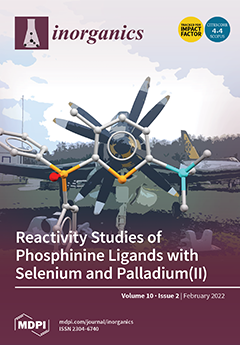Phosphinines and donor-substituted phosphinines are of recent interest due to their use in homogeneous catalysis. In this article, a Pd(II) bis(phosphinine) complex was characterised and phosphorus–selenium coupling constants were used to assess the donor properties of the diphenylphosphine substituents of phosphinine ligands to promote their further use in catalysis. The selenation of 2,5-bis(diphenylphosphino)-3,6-dimethylphosphinine (
5) and 2-diphenylphosphino-3-methyl-6-trimethylsilylphosphinine (
6) gave the corresponding phosphine selenides
8 and
9, respectively, leaving the phosphinine ring intact. Multinuclear NMR spectroscopy, mass spectrometry and single crystal X-ray diffraction confirmed the oxidation of all the diphenylphosphine substituents with
1JP-Se coupling constants determined to be similar to SePPh
3, indicating that the phosphinine rings were electronically similar to phenyl substituents. Solutions of
6 were found to react with oxygen slowly to produce the phosphine oxide
10 along with other by-products. The reaction of [bis{3-methyl-6-(trimethylsilyl)phosphinine-2-yl}dimethylsilane] (
4) with [PdCl
2(COD)] gave the chelating dichloropalladium(II) complex, as determined by multinuclear NMR spectroscopy, mass spectrometry and an elemental analysis. The molecular structure of the intermediate
2 in the formation of 4,6-di(
tert-butyl)-1,3,2-diazaphosphinine (
3) was also determined, which confirmed the structure of the diazaphosphacycle P(Cl){N=C(
tBu)CH=C(
tBu)-N(H)}.
Full article





